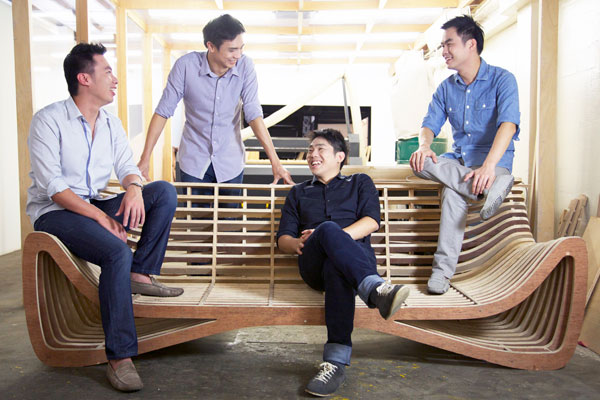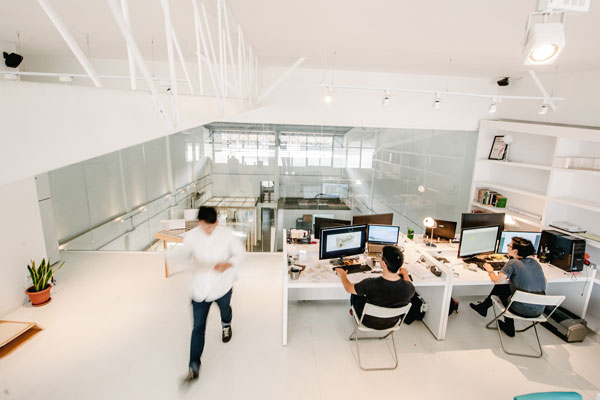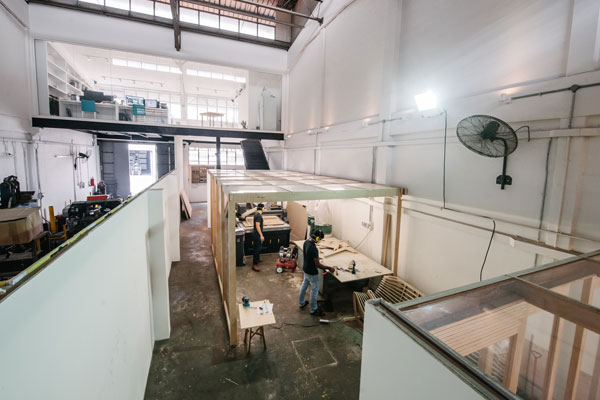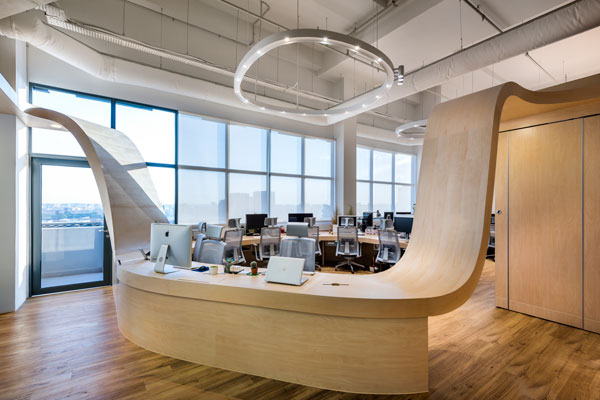At Produce Workshop, prototyping and the creation of 1:1 models is a critical part of the design process. Narelle Yabuka extends our Cubes Indesign issue 79 feature on the studio’s interior for Little Red Ants with the thoughts of Creative Director Pan Yi Cheng on prototyping, its benefits, and the associated challenges.

May 4th, 2016
Top image: ‘Producers’ at work within Produce Workshop. Photo by Mindy Tan (courtesy of Produce Workshop)
When designer Pan Yi Cheng returned to Singapore after studying and working in Europe, he was struck by the difficulty of realising some of his design ideas. “I would have to change the design or tone it down to suit what the industry here could offer. I felt that wasn’t the right direction to take,” he recalls.

Produce Workshop’s Director Yap Boon Kiat, Finance Director Stanley Tan, Creative Director Pan Yi Cheng and Director Loh Jian Hao. Photo by Elgin Quek (courtesy of Produce Workshop)
He established Produce Workshop in order to combine making with designing. “Prototyping is mainly about creating a one-off as a physical demonstration – what I call a 3D physical drawing,” he explains. “We are possibly the only design studio in Singapore that has a workshop. A lot of design students are now trained in digital fabrication, using equipment like 3D printers and laser cutters, but there isn’t a manufacturing base here that can support designers in that sense. There’s a gap in the market,” he says. “There is a lack of digital fabricators in Singapore who can really do customised products and projects.”

Produce Workshop’s studio/office overlooks the production area below. Photo by Mindy Tan (courtesy of Produce Workshop)
Produce Workshop, which counts a CNC machine and a laser cutter among its equipment, allows Pan and his team to build their own prototypes and even furniture. “So far I’d say we have been quite blessed in the sense that our first few projects had allowed us to use the machines for experiments [including Wild Rocket for Willin Low]. Subsequently we were less restricted in terms of how we design. It was much more focussed on the concept of the project, and not so hampered by an inability to find craftspeople. There were fewer restrictions and much more freedom,” he says.
“But the problem is that our design studio will always need to be housed in an industrial area,” he laments. And with industrial areas being zoned ever further from the city centre, Pan fears that Produce Workshop may someday find itself situated in the island’s farthest reaches. Currently, it is located in Eunos.
“As an industrial activity, prototyping is not as heavy as manufacturing,” he suggests, hinting that its impact on a neighbourhood is less severe. “I think Singapore could benefit from being more flexible in terms of the integration of land use,” he says.

Produce Workshop’s production area is located on the ground floor of an industrial unit in Eunos, with a mezzanine-level office space above. Photo by Mindy Tan (courtesy of Produce Workshop)
Pan continues, “The environment where designers work is crucial. If you’re in a mundane, even hostile environment every day, it could be very difficult to create anything interesting. It could become really demoralising. And if you’re far away from the city centre, how would you find staff willing to travel so far every day? Would clients want to come to your studio for meetings? I don’t think any designer would really want to be cut off from the vibrancy that the city offers.”
Manufacturing, Pan suggests, is something that can never be completely separated from the design industry. “I think the design community would very much benefit from a clustering of processes. In the design industry you have processes of learning, developing, and showing (for example in showrooms and retail spaces). If these processes were all clustered together in the same locality, within the City, there would be much more synergy. Each sector would feed off the energy of the others.”

For Little Red Ants Creative Studio, Produce Workshop designed a fluid office interior with an infinite, looping table. Prototyping of the curved parts was done in-house. Photo by Edward Hendricks (courtesy of Produce Workshop)
And with stronger prototyping and automation, there would be less need to outsource production work to regional neighbours such as Indonesia, Thailand and Vietnam – a process that has its own set of challenges (including the carbon footprint associated with transportation, and the impact of a stop-start design process in the case of prototyping).
“Singapore already has a community of people who are making their own things, although they are not working at the larger scale of furniture and so on. They’re doing, for example, leather crafts. I think it’s a matter of time until people will want to do this beyond the hobby level. Then the community will start to grow. In fact, different design disciplines and trades could really work together. For example, we might be looking for leather products to use as finishing materials. When more people offer that kind of service, then things will be much more fluid.”
The community of people interested in making is slowly growing, suggests Pan. “But I do think that space is one of the key issues that is not allowing it to become common,” he adds.
Produce Workshop
produce.com.sg
A searchable and comprehensive guide for specifying leading products and their suppliers
Keep up to date with the latest and greatest from our industry BFF's!

XTRA celebrates the distinctive and unexpected work of Magis in their Singapore showroom.

In this candid interview, the culinary mastermind behind Singapore’s Nouri and Appetite talks about food as an act of human connection that transcends borders and accolades, the crucial role of technology in preserving its unifying power, and finding a kindred spirit in Gaggenau’s reverence for tradition and relentless pursuit of innovation.
The internet never sleeps! Here's the stuff you might have missed

Kokaistudios’ first Singapore project is an 846-square-metre hospitality interior celebrating cultural synergy through its dynamic and vibrant aesthetics.

A vacant plot in the heart of Wolli Creek in Bayside in South Sydney has been transformed by CONTEXT into a vibrant community park.